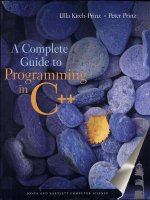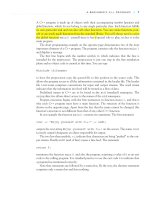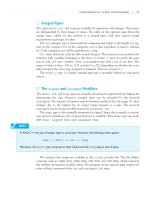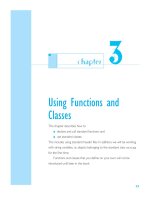A Complete Guide to Programming in C++ part 12 ppsx
Bạn đang xem bản rút gọn của tài liệu. Xem và tải ngay bản đầy đủ của tài liệu tại đây (244.21 KB, 10 trang )
RELATIONAL OPERATORS
■
89
ᮀ The Result of Comparisons
Each comparison in C++ is a bool type expression with a value of true or false,
where true means that the comparison is correct and false means that the compari-
son is incorrect.
Example: length == circuit // false or true
If the variables length and circuit contain the same number, the comparison is
true and the value of the relational expression is true. But if the expressions contain
different values, the value of the expression will be false.
When individual characters are compared, the character codes are compared. The
result therefore depends on the character set you are using. The following expression
results in the value true when ASCII code is used.
Example: 'A' < 'a' // true, since 65 < 97
ᮀ Precedence of Relational Operators
Relational operators have lower precedence than arithmetic operators but higher prece-
dence than assignment operators.
Example: bool flag = index < max – 1;
In our example, max – 1 is evaluated first, then the result is compared to index, and the
value of the relational expression (false or true) is assigned to the flag variable.
Similarly, in the following
Example: int result;
result = length + 1 == limit;
length + 1
is evaluated first, then the result is compared to limit, and the value of
the relational expression is assigned to the result variable. Since result is an int
type, a numerical value is assigned instead of false or true, i.e. 0 for false and 1 for
true.
It is quite common to assign a value before performing a comparison, and parentheses
must be used in this case.
Example: (result = length + 1) == limit
Our example stores the result of length + 1 in the variable result and then compares
this expression with limit.
You cannot use the assignment operator = to compare two expressions. The compiler will not generate
an error message if the value on the left is a variable. This mistake has caused headaches for lots of
beginners when troubleshooting their programs.
✓
NOTE
90
■
CHAPTER 5 OPERATORS FOR FUNDAMENTAL TYPES
A numeric value, such as x or x+1, is interpreted as “false” if its value is 0. Any value other than 0 is
interpreted as “true.”
✓
NOTE
■
LOGICAL OPERATORS
“Truth” table for logical operators
Examples for logical expressions
true
true true
false
false
true
false
false
false
true
true
false
false
true
true
false
A B A && B A || B
true
false true
false
A!A
1
0
-1
0
-1
0
0
1
false
true
true
false
x <= y || y >=0
x > -2 && y == 0
x && !y
!(x+1) || y - 1 > 0
x y ResultLogical Expression
LOGICAL OPERATORS
■
91
The logical operators comprise the boolean operators && (AND), || (OR), and ! (NOT).
They can be used to create compound conditions and perform conditional execution of a
program depending on multiple conditions.
A logical expression results in a value false or true, depending on whether the log-
ical expression is correct or incorrect, just like a relational expression.
ᮀ Operands and Order of Evaluation
The operands for boolean type operators are of the bool type. However, operands of any
type that can be converted to bool can also be used, including any arithmetic types. In
this case the operand is interpreted as false, or converted to false, if it has a value of
0. Any other value than 0 is interpreted as true.
The OR operator || will return true only if at least one operand is true, so the value
of the expression
Example: (length < 0.2) || (length > 9.8)
is true if length is less than 0.2 or greater than 9.8.
The AND operator && will return true only if both operands are true, so the logical
expression
Example: (index < max) && (cin >> number)
is true, provided index is less than max and a number is successfully input. If the con-
dition index < max is not met, the program will not attempt to read a number! One
important feature of the logical operators && and || is the fact that there is a fixed order
of evaluation. The left operand is evaluated first and if a result has already been ascer-
tained, the right operand will not be evaluated!
The NOT operator ! will return true only if its operand is false. If the variable flag
contains the value false (or the value 0), !flag returns the boolean value true.
ᮀ Precedence of Boolean Operators
The && operator has higher precedence than ||. The precedence of both these operators
is higher than the precedence of an assignment operator, but lower than the precedence
of all previously used operators. This is why it was permissible to omit the parentheses in
the examples earlier on in this chapter.
The ! operator is a unary operator and thus has higher precedence. Refer to the table
of precedence in the Appendix for further details.
exercises
92
■
CHAPTER 5 OPERATORS FOR FUNDAMENTAL TYPES
// Evaluating operands in logical expressions.
#include <iostream>
using namespace std;
int main()
{
cout << boolalpha; // Outputs boolean values
// as true or false
bool res = false;
int y = 5;
res = 7 || (y = 0);
cout << "Result of (7 || (y = 0)): " << res
<< endl;
cout << "Value of y: " << y << endl;
int a, b, c;
a = b = c = 0;
res = ++a || ++b && ++c;
cout << '\n'
<< " res = " << res
<< ", a = " << a
<< ", b = " << b
<< ", c = " << c << endl;
a = b = c = 0;
res = ++a && ++b || ++c;
cout << " res = " << res
<< ", a = " << a
<< ", b = " << b
<< ", c = " << c << endl;
return 0;
}
■
EXERCISES
Program listing for exercise 4
EXERCISES
■
93
Exercise 1
What values do the following arithmetic expressions have?
a.
3/10 b. 11%4 c. 15/2.0
d. 3 + 4 % 5 e. 3 * 7 % 4 f. 7 % 4 * 3
Exercise 2
a. How are operands and operators in the following expression associated?
x = –4 * i++ – 6 % 4;
Insert parentheses to form equivalent expressions.
b. What value will be assigned in part a to the variable
x if the variable i has a
value of
–2?
Exercise 3
The int variable x contains the number 7. Calculate the value of the following
logical expressions:
a.
x < 10 && x >= –1
b. !x && x >= 3
c. x++ == 8 || x == 7
Exercise 4
What screen output does the program on the opposite page generate?
solutions
94
■
CHAPTER 5 OPERATORS FOR FUNDAMENTAL TYPES
■
SOLUTIONS
Exercise 1
a. 0 b. 3 c. 7.5
d. 7 e. 1 f. 9
Exercise 2
a. x = ( ((–4) * (i++)) – (6 % 4) )
b. The value 6 will be assigned to the variable x.
Exercise 3
a. true
b. false
c. false
Exercise 4
Result of (7 || (y = 0)): true
Value of y: 5
res = true, a = 1, b = 0, c = 0
res = true, a = 1, b = 1, c = 0
95
Control Flow
This chapter introduces the statements needed to control the flow of a
program.These are
■ loops with while, do-while, and for
■ selections with if-else, switch, and the conditional operator
■ jumps with goto, continue, and break.
chapter
6
96
■
CHAPTER 6 CONTROL FLOW
// average.cpp
// Computing the average of numbers
#include <iostream>
using namespace std;
int main()
{
int x, count = 0;
float sum = 0.0;
cout << "Please enter some integers:\n"
"(Break with any letter)"
<< endl;
while( cin >> x )
{
sum += x;
++count;
}
cout << "The average of the numbers: "
<< sum / count << endl;
return 0;
}
As long as the expression is true
statement
■
THE while STATEMENT
Structogram for while
Sample program
Sample output from the above program
Please enter some integers:
(Break with any letter)
9 10 12q
The average of the numbers: 10.3333
THE WHILE STATEMENT
■
97
Loops are used to perform a set of instructions repeatedly. The set of instructions to be
iterated is called the loop body. C++ offers three language elements to formulate iteration
statements: while, do-while, and for. The number of times a loop is repeated is
defined by a controlling expression. In the case of while and for statements this expres-
sion is verified before the loop body is executed, whereas a do-while loop is performed
once before testing.
The while statement takes the following format:
Syntax: while( expression )
statement // loop body
When entering the loop, the controlling expression is verified, i.e. the expression is
evaluated. If this value is true, the loop body is then executed before the controlling
expression is evaluated once more.
If the controlling expression is false, i.e. expression evaluates to false, the pro-
gram goes on to execute the statement following the while loop.
It is common practice to place the loop body in a new line of the source code and to
indent the statement to improve the readability of the program.
Example: int count = 0;
while( count < 10)
cout << ++count << endl;
As this example illustrates, the controlling expression is normally a boolean expression.
However, the controlling expression might be any expression that can be converted to
the bool type including any arithmetic expressions. As we already learned from the sec-
tion on boolean operators, the value 0 converts to false and all other values convert to
true.
ᮀ Building Blocks
If you need to repeat more than one statement in a program loop, you must place the
statements in a block marked by parentheses { }. A block is syntactically equivalent to a
statement, so you can use a block wherever the syntax requires a statement.
The program on the opposite page calculates the average of a sequence of integers
input via the keyboard. Since the loops contains two statements, the statements must be
placed in a block.
The controlling expression cin >> x is true provided the user inputs an integer.
The result of converting the expression cin >> x to a bool type will be true for any
valid input and false in any other case. Invalid input, if the user types a letter instead
of an integer, for example, terminates the loop and executes the next statement.
98
■
CHAPTER 6 CONTROL FLOW
// Euro1.cpp
#include <iostream>
#include <iomanip>
using namespace std;
int main()
{
double rate = 1.15; // Exchange rate:
// one Euro to one Dollar
cout << fixed << setprecision(2);
cout << "\tEuro \tDollar\n";
for( int euro = 1; euro <= 5; ++euro)
cout << "\t " << euro
<< "\t " << euro*rate << endl;
return 0;
}
■
THE for STATEMENT
Structogram for for
Sample program
Screen output
Euro Dollar
1 0.95
2 1.90
3 2.85
4 3.80
5 4.75
expression1
statement
expression3
As long as expression2 is true









